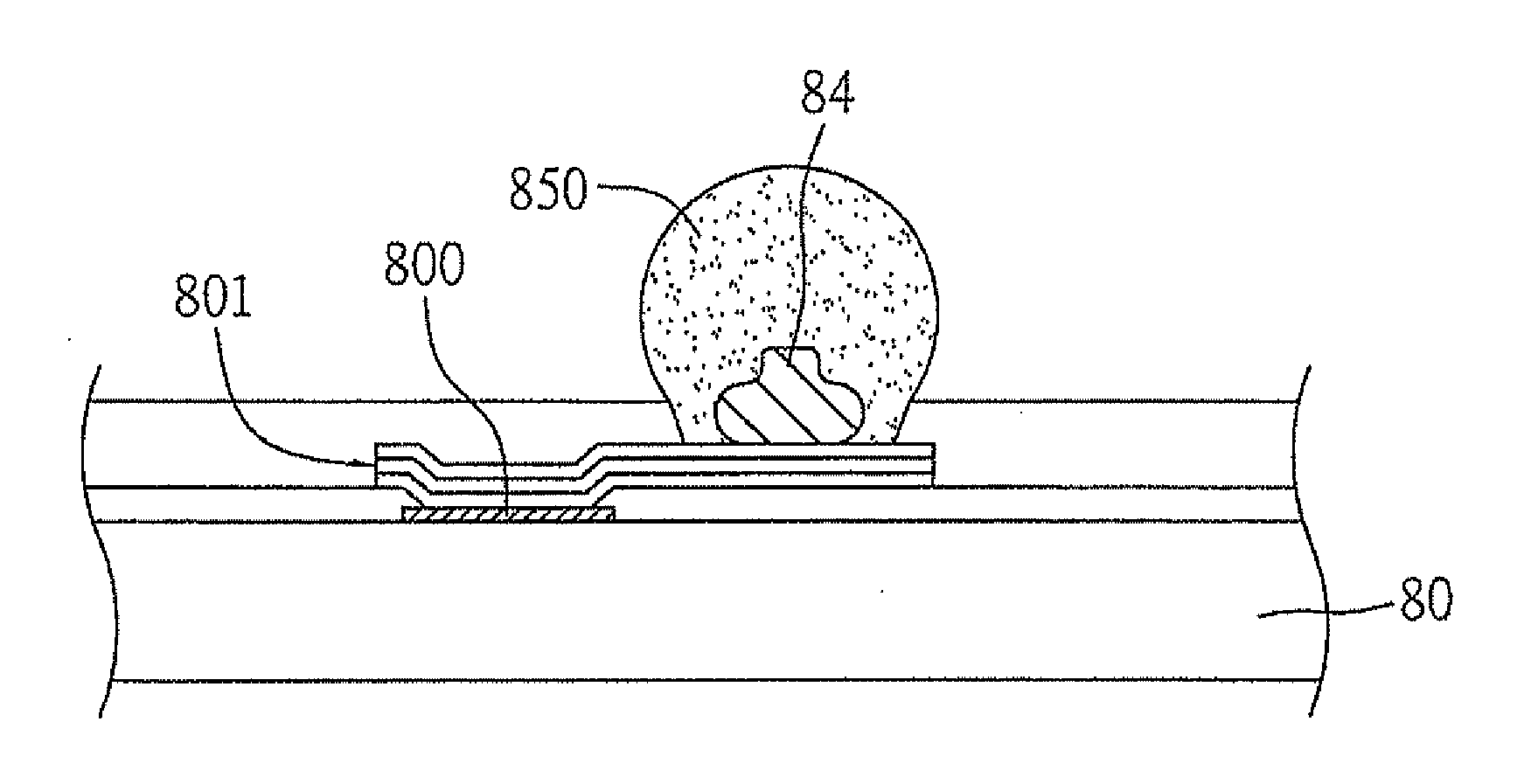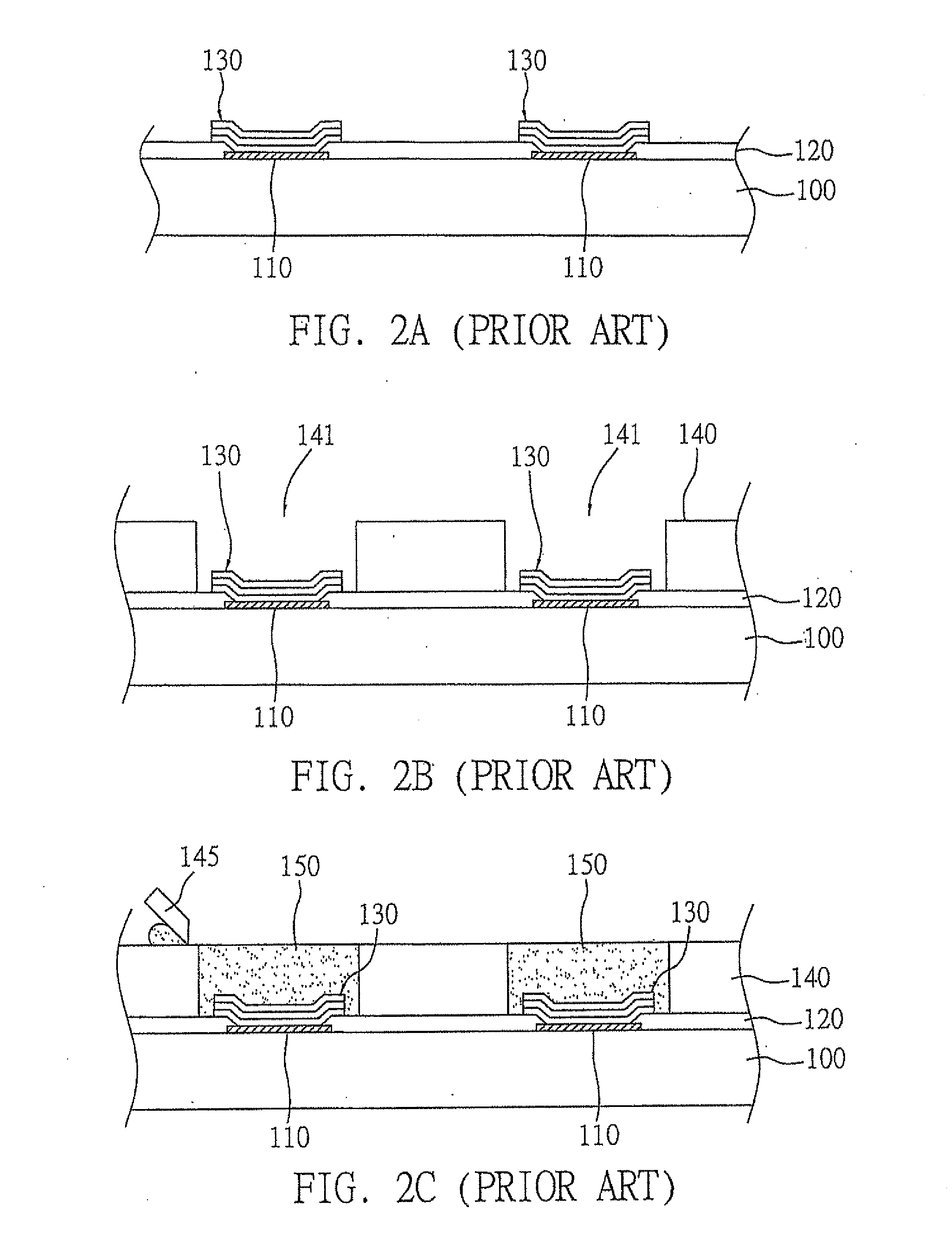Conductive bump structure for semiconductor device and fabrication method thereof
a technology of conductive bumps and semiconductor devices, which is applied in the direction of semiconductor devices, basic electric elements, electrical apparatus, etc., can solve the problems of bump cracking, easy cracking of solder bumps, and poor prior art fabricated structure of common solder bumps, etc., to achieve simple and low-cost fabrication processes, increase the bonding area of solder materials, and reduce the effect of bump cracking
- Summary
- Abstract
- Description
- Claims
- Application Information
AI Technical Summary
Benefits of technology
Problems solved by technology
Method used
Image
Examples
first preferred embodiment
[0036]FIGS. 5A to 5E are schematic cross-sectional views showing a method for fabricating a conductive bump structure for a semiconductor device according to a first embodiment of the present invention.
[0037]As shown in FIG. 5A, a semiconductor device 50 with a connection pad 500 formed thereon is provided and a passivation layer 51 exposing the connection pad 500 is formed on the semiconductor device 50 such that an under bump metallurgy (UBM) structure 52 is formed on the connection pad 500 of the semiconductor device, wherein the UBM structure 52 is sized larger than the connection pad 500. The semiconductor device 50 may be used in a substrate for semiconductor package or a tape carrier such as a tape carrier package (TCP). The semiconductor device 50 may also be used in a printed circuit board for assembling electrical components in second phase. Furthermore, the semiconductor device may be used in a wafer / chip integrated circuit structure that may subsequently be used as a fli...
second preferred embodiment
[0045]FIGS. 6A to 6F are schematic cross-sectional views showing a method of fabricating a conductive bump structure for a semiconductor device according to a second embodiment of the present invention.
[0046]As shown in FIGS. 6A and 6B, a semiconductor device 60 with a connection pad 600 formed thereon is provided and a passivation layer 61 exposing the connection pad 600 is formed on the semiconductor device 60. Thereafter a metal layer 620 and a resist layer 63 are applied in sequence over the semiconductor device 60, wherein the resist layer 63 has an opening 630 corresponding to the connection pad 600 for exposing a portion of the metal layer 620. The metal layer 620 may have one or more layers and be used as a current conduction path during plating process for forming solder, as well as reserving a portion of metal layer 620 at a position corresponding to the connection pad 600 for subsequently forming an UBM structure. The metal layer 620 may be formed by physical methods such...
third preferred embodiment
[0051]FIG. 7 is a schematic cross-sectional view showing a conductive bump structure for a semiconductor device according to a third embodiment of the present invention.
[0052]The method of fabricating the conductive bump structure for semiconductor device in the present embodiment is similar to the method disclosed in the first or the second embodiment; however the differences are that the present embodiment comprises a conductive bump structure that is applied to a wafer level chip scale package (WLCSP) structure, and a redistribution layer 701 (RDL) electrically connecting to and formed on at least a connection pad 700 of a chip 70, wherein the existing connection pad 700 may be redistributed through the redistribution layer 701 electrically connected to the connection pad 700. Subsequently, an UBM structure 72 and a metal bump 74 are formed on a suitable position on the redistribution layer 701 that serves as a new connection pad 702, wherein the metal bump 74 is sized smaller th...
PUM
 Login to View More
Login to View More Abstract
Description
Claims
Application Information
 Login to View More
Login to View More - R&D
- Intellectual Property
- Life Sciences
- Materials
- Tech Scout
- Unparalleled Data Quality
- Higher Quality Content
- 60% Fewer Hallucinations
Browse by: Latest US Patents, China's latest patents, Technical Efficacy Thesaurus, Application Domain, Technology Topic, Popular Technical Reports.
© 2025 PatSnap. All rights reserved.Legal|Privacy policy|Modern Slavery Act Transparency Statement|Sitemap|About US| Contact US: help@patsnap.com



